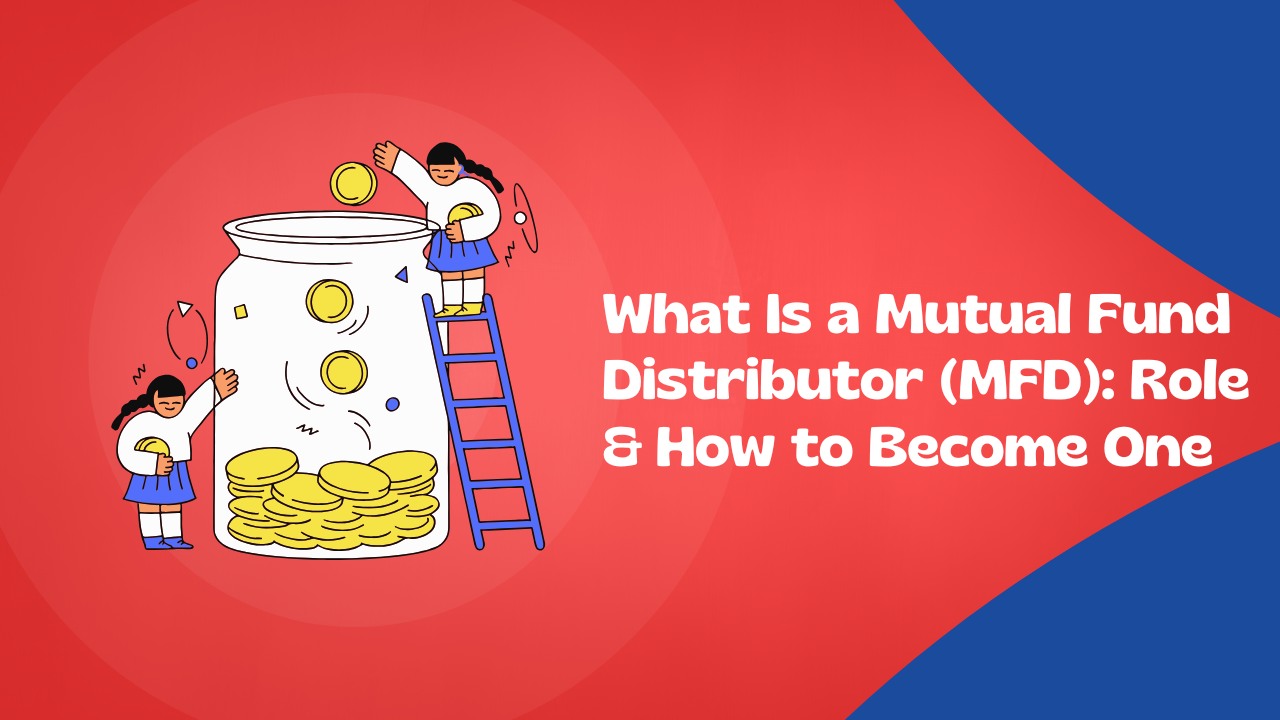What Is a Mutual Fund Distributor (MFD)| Role & How to Become One
A mutual fund distributor, often abbreviated as MFD, serves as the bridge between investors and asset management companies (AMCs). Distributors help ordinary investors discover suitable mutual fund schemes, complete purchase and redemption paperwork, and navigate the numerous choices and regulatory formalities that can be overwhelming for someone new to investing.
Unlike fee-only financial advisors who charge for advice, many distributors earn commissions paid by AMCs for bringing in business, though the industry has been moving toward greater transparency and alignment with investor interests.
What distributors actually do
At its core, the distributor’s job is threefold: educate, facilitate, and service. Distributors explain fund categories (equity, debt, hybrid, ELSS, etc.), help match schemes to an investor’s risk profile and goals, and carry out transactions, such as subscribing to new plans, switching between schemes, or processing redemptions.
Beyond transactions, effective distributors provide periodic portfolio reviews, help with KYC and nominee updates, and assist clients with paperwork related to SIPs (systematic investment plans) and tax reporting. Good distributors also act as an informal compliance filter, flagging suitability issues and ensuring documentation is complete before submission.
Who regulates mutual fund distributors in India?
In India, the mutual fund distribution ecosystem is shaped by two principal bodies. The Securities and Exchange Board of India (SEBI) oversees the financial markets and frames rules that affect distributors indirectly through product and disclosure norms, while the Association of Mutual Funds in India (AMFI) administers distributor registration and the AMFI Registration Number (ARN) system. To operate legitimately, distributors must obtain an ARN and meet certain educational/certification requirements set by regulators and AMFI.
How distributors get paid
Traditionally, distributors received commissions from AMCs as a percentage of the investment amount (or the AUM they sourced). Commission structures vary by scheme type and AMC, but typical upfront or trail commissions often range from a fraction of a percent to around two percent, depending on the product and time horizon.
Recent industry dynamics and regulatory nudges have prompted more investor-friendly practices, but distribution remains a significant revenue stream. Industry-wide commission payouts in recent years have grown substantially, reflecting the rising mutual fund flows.
If you plan to become a distributor, treat commission as a component of viability but not the whole story; trust, service quality, and client retention drive long-term earnings.
How to become mutual fund distributor (MFD) in India
Becoming a distributor requires a combination of certification, registration, documentation, and distribution partnership-building. The usual path is practical and accessible for motivated people.
First, obtain the required certification. The National Institute of Securities Markets (NISM) conducts the Mutual Fund Distributors Certification Examination (NISM-Series-V-A). The exam tests core knowledge about mutual funds, taxation, regulatory aspects, and the practical mechanics of distribution.
It is a two-hour computer-based test, typically with 100 multiple-choice questions and a passing score requirement (details and frequencies are published by NISM). Passing this exam establishes a baseline competency and is a regulatory expectation before registering with AMFI.
Second, register with AMFI and obtain an ARN. After clearing the NISM exam, you apply to AMFI for an AMFI Registration Number (ARN). The ARN enables a distributor to empanel with AMCs and receive commission/payouts for client transactions.
AMFI’s website lists the documents required for individual and corporate distributors, along with application processes and renewal norms. Keep in mind AMFI periodically updates documentation and processes, so check AMFI’s official guidance when you apply.
Third, build relationships with Asset Management Companies and distribution platforms. With an ARN in hand, you can empanel with multiple AMCs, sign distributor agreements, and start onboarding clients. Many distributors use a mix of direct AMC empanelment, partnership with distributor networks, or digital distribution platforms that provide backend support (onboarding tech, reconciliations, consolidated reporting).
Choosing the right mix depends on whether you want to remain an independent agent, join a larger distributor firm, or run a digital-first distribution business.
Finally, meet ongoing continuing professional education (CPE) and compliance requirements. AMFI and NISM have programs for continuing education and may require distributors to attend CPE sessions for ARN renewal.
Maintain accurate client records, follow KYC and AML norms, and ensure all advice and sales comply with suitability and disclosure rules. This protects both clients and your long-term business.
Skills and traits that make a successful distributor
Success in distribution is not just regulatory boxes — it’s a business built on trust. Strong communicators who can simplify financial concepts and genuinely listen to client goals tend to win and retain business. Operational discipline (timely reconciliations, accurate forms, SIP follow-ups), basic financial planning know-how, and ethical behaviour are critical.
Technology savviness helps: distributors who use CRM tools, digital onboarding, and automated reminders provide a superior client experience. Networking, a local reputation for honesty, and a focus on customer outcomes typically translate into a more sustainable income stream than chasing short-term commissions.
Typical earnings and career pathways
Earnings vary widely. New distributors often start modestly, earning through upfront commissions on transactions and trail commissions as client portfolios grow. Established distributors with a steady book of clients can earn meaningful recurring income through trail commissions and advisory fees (if they also register as a fee-based adviser under the RIA regime).
Industry reports show commission pools have risen substantially in recent years, indicating that distributors who scale can do well financially. But growth takes time: client acquisition, retention, and portfolio appreciation are cumulative, so patience and consistent service matter more than quick wins.
Practical tips for getting started today
If you’re ready to take the leap, start by booking the NISM-Series-V-A exam prep resources that are widely available and the syllabus is practical. Simultaneously, prepare your identity and address proofs (PAN, Aadhaar, bank mandate), and review AMFI’s document checklist.
Consider partnering with a distributor network or a digital platform that provides back-office, compliance, and tech support in exchange for a share of commissions while you build your own client base. Always keep client interests first: transparent disclosures, documented suitability discussions, and timely service build trust faster than any sales pitch.
Challenges and the changing landscape
The distribution industry is evolving. Regulatory changes aimed at lowering costs and improving transparency have reshaped how distributors are incentivised. SEBI and AMFI periodically revise payout norms, disclosure requirements, and how certain charges are applied, all of which can affect distributor revenue and operational practices.
Digital platforms, direct plans, and investor preference for lower-cost options mean distributors must shift from product-pushing to advisory-driven, service-centric models to stay relevant. Embrace continuous learning and technology to navigate these changes.
Conclusion
Becoming a mutual fund distributor combines regulated certification, client-facing skills, and solid business discipline. It’s a role that allows you to help people meet financial goals while building a recurring-income business.
Start with the NISM exam, secure your AMFI ARN, and choose distribution partners that match your long-term vision. Above all, focus on client outcomes when investors succeed, your distribution business grows sustainably.

